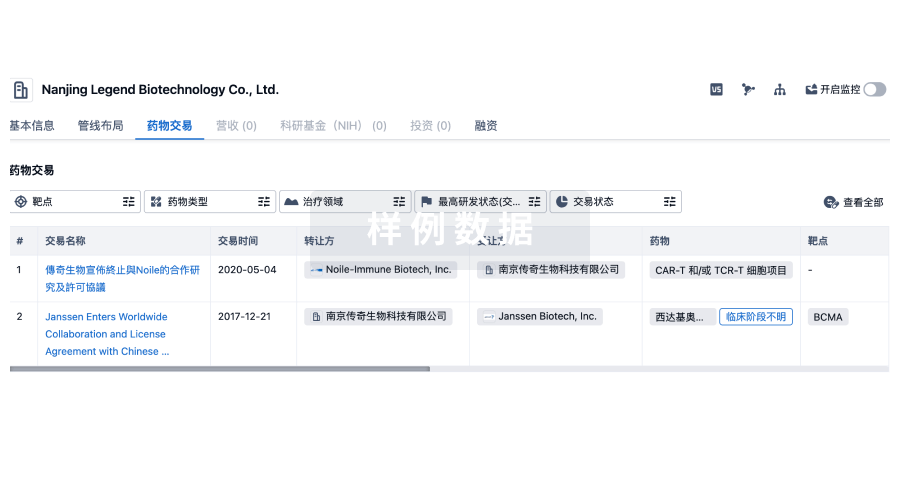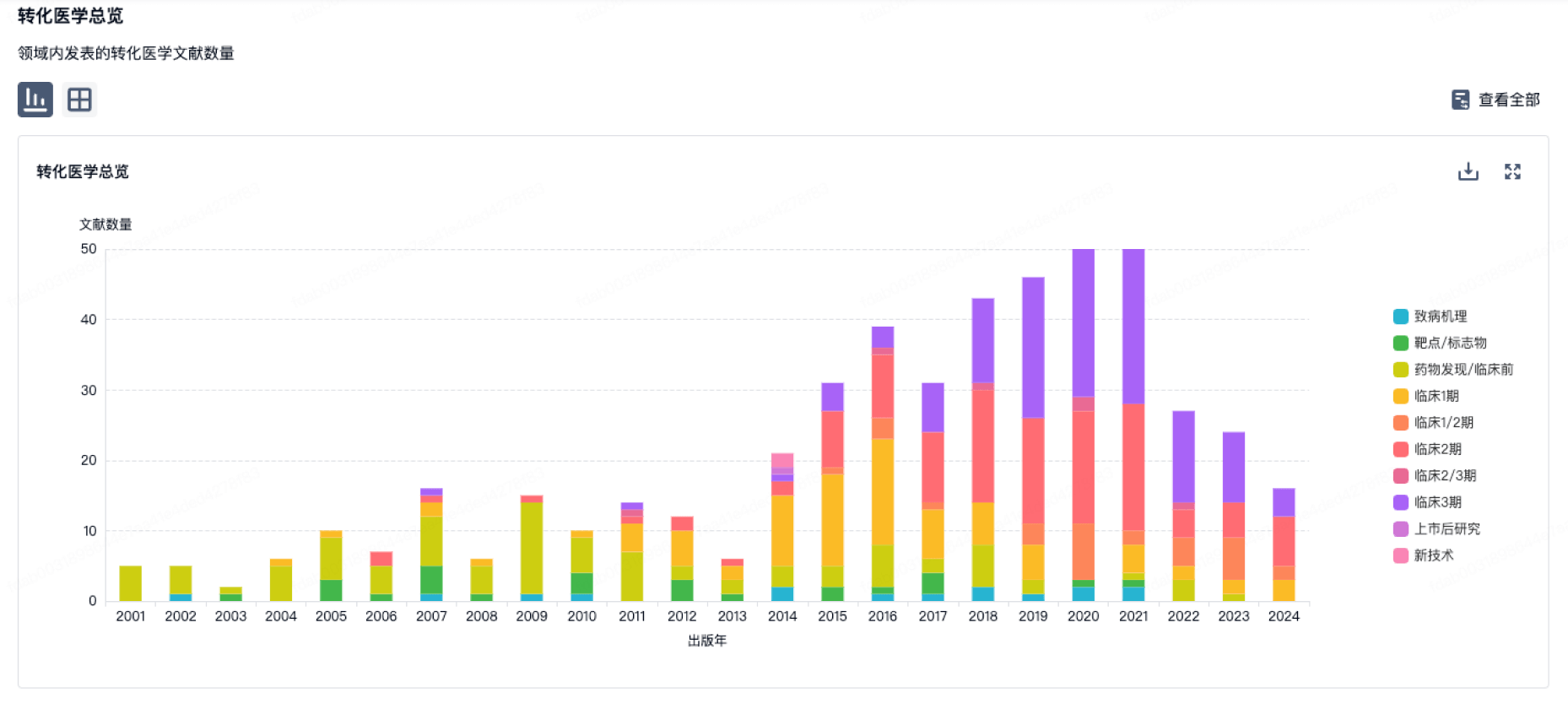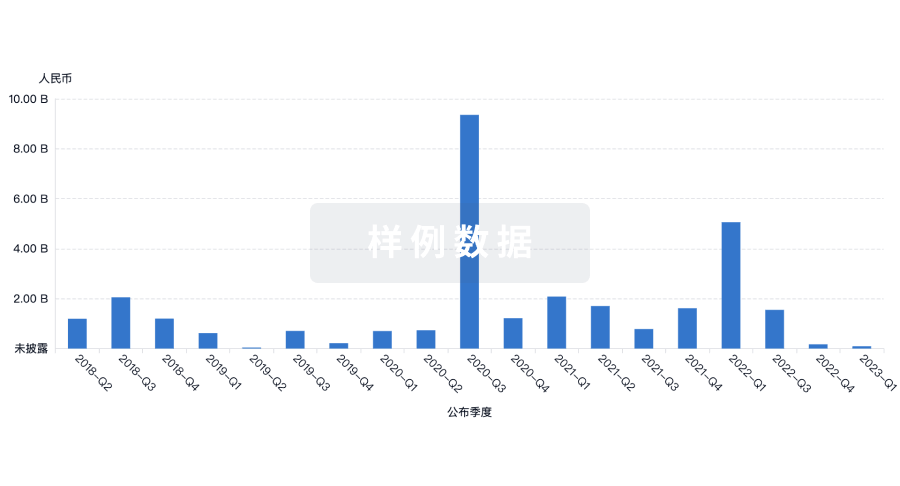预约演示
更新于:2025-12-06

Trinity College Dublin
更新于:2025-12-06
概览
标签
遗传病与畸形
眼部疾病
消化系统疾病
腺相关病毒基因治疗
小分子化药
疾病领域得分
一眼洞穿机构专注的疾病领域
暂无数据
技术平台
公司药物应用最多的技术
暂无数据
靶点
公司最常开发的靶点
暂无数据
| 排名前五的药物类型 | 数量 |
|---|---|
| 腺相关病毒基因治疗 | 2 |
| 小分子化药 | 1 |
关联
3
项与 Trinity College Dublin 相关的药物靶点- |
作用机制- |
非在研适应症- |
最高研发阶段临床前 |
首次获批国家/地区- |
首次获批日期- |
作用机制 Mitochondrial complex I (NADH dehydrogenase)调节剂 |
在研适应症 |
非在研适应症- |
最高研发阶段临床前 |
首次获批国家/地区- |
首次获批日期- |
靶点- |
作用机制 Gene transference |
在研适应症 |
非在研适应症- |
最高研发阶段药物发现 |
首次获批国家/地区- |
首次获批日期- |
133
项与 Trinity College Dublin 相关的临床试验NCT07196020
Prediction and Prevention of Venous Thrombo-embolism(VTE) During Chemotherapy Using Serial Determination of Haemostasis Biomarkers.
Cancer patients are at higher risk of getting a blood clot (known as venous thromboembolism (VTE)) especially during chemotherapy and some patients are more at risk than others. These clots can be prevented by using blood thinners (known as anticoagulants) but these are not suitable for everyone as they also carry a risk of bleeding. This study aims to identify which chemotherapy patients are most at risk of a blood clot and at what point in their treatment this is likely to happen. In this project biomarkers in the blood that are involved in blood clotting will be measured in cancer patients at four stages during chemotherapy to see how the biomarkers change during treatment. The blood samples for these tests are taken at the same time as the normal routine blood tests done before a chemotherapy cycle. Biomarker levels will be compared between those patients who subsequently get a VTE and those who do not get a VTE. This will help develop a biomarker based blood test to predict clots during chemotherapy. The biomarker based test will also be compared with other methods of predicting VTE in cancer patients which are currently in use. In the future, this blood test might be used to see if patients are at high risk of a clot during chemotherapy and provide a method to optimise the use of preventative anticoagulants in cancer patients during chemotherapy.
开始日期2025-10-01 |
申办/合作机构 |
NCT07182773
Pre-infusion Aerobic Cycling Exercise for CardioRespiratory Fitness in Cancer Patients
Background to this Research Patients who undergo cancer treatment involving chemotherapy or immunotherapy, can experience considerable reductions in their fitness levels. This is a concern, as exercise is a really important part of cancer care. Therefore delivering exercise programmes that support patients during their chemotherapy or immunotherapy treatment will be essential to helping people to maintain their fitness levels. Research is needed to examine the best way to introduce exercise into the patient pathway in a way that is convenient and patient-centred.
The Specific Questions Being Asked This research project aims to examine the effect of an exercise programme which involves exercising on the cancer treatment day ward with a physiotherapist while waiting for treatment infusion as a safe and effective way of supporting patients to keep fit and active during chemotherapy treatment. The trial will also investigate if it the prescribed moderate intensity exercise for 30 minutes is manageable for patients.
Trial Plan This project will be delivered as a randomised controlled trial. All participants enrolled on the trial will receive information and advice about physical activity during chemotherapy treatment from a physiotherapist with expertise in cancer care. The intervention arm will also complete an exercise session with the physiotherapist on the day of their infusion treatment over a period of 12 weeks.
The feasibility of this protocol has already been tested in 17 participants with very positive results. The information gained from this initial study will be used to deliver this trial, which will recruit 80 participants. It is hoped that the information gained from this research will provide a practical way of providing supervised exercise training for patients during chemotherapy or immunotherapy that is safe, expert-led and patient centred.
The Specific Questions Being Asked This research project aims to examine the effect of an exercise programme which involves exercising on the cancer treatment day ward with a physiotherapist while waiting for treatment infusion as a safe and effective way of supporting patients to keep fit and active during chemotherapy treatment. The trial will also investigate if it the prescribed moderate intensity exercise for 30 minutes is manageable for patients.
Trial Plan This project will be delivered as a randomised controlled trial. All participants enrolled on the trial will receive information and advice about physical activity during chemotherapy treatment from a physiotherapist with expertise in cancer care. The intervention arm will also complete an exercise session with the physiotherapist on the day of their infusion treatment over a period of 12 weeks.
The feasibility of this protocol has already been tested in 17 participants with very positive results. The information gained from this initial study will be used to deliver this trial, which will recruit 80 participants. It is hoped that the information gained from this research will provide a practical way of providing supervised exercise training for patients during chemotherapy or immunotherapy that is safe, expert-led and patient centred.
开始日期2025-09-01 |
申办/合作机构 |
NCT06523374
Endoscopic Brush Cytology and Single Cell Clonal Dynamics of Early Esophageal Adenocarcinoma for Defining Cost Effective Surveillance Strategies and Prediction of Cancer Recurrence: Prospective Pilot Cohort Study in Preparation of a Randomized Controlled Trial to Determine the Feasibility of a Risk Stratification Model for Barrett Esophagus Patients Based on Brush Cytology, and to Test Novel High Throughput Methods for Assessing Biomarkers for Future Use
This study serves, in part, to prepare for a future large cohort study. The goal of the study is:
1. The collection of various tissue samples (blood, biopsies and "esophageal brushes") and their analysis.
2. To set up standardized methods for different genetic analyses (DNA-FISH and so-called single cell sequencing) on the esophageal tissue samples.
3. Evaluating the quality of life of Barrett's Esophagus patients and the degree of fear of getting cancer.
Patients with a Barrett's Esophagus can participate in the study if they are minimally 18 years old, are capable of giving informed consent (fully understanding what the study entails before giving consent to participate), have Barrett Esophagus and are referred to one of the participating centers due to suspicion of high-grade dysplasia or early esophageal cancer, for which the participant will be evaluated by endoscopic imaging and biopsy.
Study procedures:
* An intake consultation will be planned, wherein the eligibility criteria will be assessed, and participant characteristics will be collected.
* A routine gastroscopy will be planned twice during which several minimally-invasive interventions will be performed: drawing a blood sample, brush cytology during the endoscopy (a brush is used to obtain cells from the surface of the esophagus) and obtaining biopsy samples (small pieces of tissue). Each participant will need to undergo all the interventions.
* Patients will have to complete questionnaires at three time points to assess their quality of life (EQ-5D-DL questionnaire) and fear of cancer recurrence (Cancer Worry Scale).
1. The collection of various tissue samples (blood, biopsies and "esophageal brushes") and their analysis.
2. To set up standardized methods for different genetic analyses (DNA-FISH and so-called single cell sequencing) on the esophageal tissue samples.
3. Evaluating the quality of life of Barrett's Esophagus patients and the degree of fear of getting cancer.
Patients with a Barrett's Esophagus can participate in the study if they are minimally 18 years old, are capable of giving informed consent (fully understanding what the study entails before giving consent to participate), have Barrett Esophagus and are referred to one of the participating centers due to suspicion of high-grade dysplasia or early esophageal cancer, for which the participant will be evaluated by endoscopic imaging and biopsy.
Study procedures:
* An intake consultation will be planned, wherein the eligibility criteria will be assessed, and participant characteristics will be collected.
* A routine gastroscopy will be planned twice during which several minimally-invasive interventions will be performed: drawing a blood sample, brush cytology during the endoscopy (a brush is used to obtain cells from the surface of the esophagus) and obtaining biopsy samples (small pieces of tissue). Each participant will need to undergo all the interventions.
* Patients will have to complete questionnaires at three time points to assess their quality of life (EQ-5D-DL questionnaire) and fear of cancer recurrence (Cancer Worry Scale).
开始日期2025-07-01 |
申办/合作机构 |
100 项与 Trinity College Dublin 相关的临床结果
登录后查看更多信息
0 项与 Trinity College Dublin 相关的专利(医药)
登录后查看更多信息
20,010
项与 Trinity College Dublin 相关的文献(医药)2026-02-01·JOURNAL OF COLLOID AND INTERFACE SCIENCE
Chiral multinary quantum dots through composition control: Toward next-generation semiconductor nanomaterials
Article
作者: Gun'ko, Yurii K ; García-Melchor, Max ; Ciotti, Anna ; Branzi, Lorenzo ; Feehily, Erin ; Kavanagh, Aoife
Chirality is a fundamental property of matter with far-reaching implications in chemistry, biology, and materials science. The emergence of chirality in inorganic nanomaterials has attracted growing attention due to both its fundamental significance for the design of novel nanostructures with unprecedented control on morphology and properties, as well as for its intrinsic potential in advanced applications. Herein, we report a novel strategy for the design of chiral nanomaterials by exploiting the precise tuning of the chemical composition of the nanocrystal. In this way, we successfully optimized the chiroptical activity in a broad compositional space of ternary and quaternary I-III-VI quantum dots (QDs) based on silver, copper, and indium sulfides. Our research reveals a clear threshold for chirality in relation to the chemical composition of the luminescent multinary nanocrystals. In particular, the magnitude of the chiroptical activity is directly related to the trivalent indium content, and only QDs produced in the compositional space of the indium-rich MIn₅S₈ phases (M = Ag, Cu) exhibit chiroptical activity, whereas the indium-poor MInS₂ counterparts remain consistently achiral. This compositional control of chirality arises from the distinct surface coordination environments, which govern the binding affinity and orientation of the chiral ligands on the QDs' surface, as demonstrated by computational studies. These findings establish a detailed mechanism for chirality induction in excitonic semiconductor nanomaterials and offer new design strategies for engineering chiral QDs through targeted control of their composition and surface chemistry.
2026-02-01·JOURNAL OF CRITICAL CARE
Authors reply: “Microcirculation properties of 20 % albumin in Sepsis; a randomised controlled trial”
Letter
作者: Connolly, E ; Cusack, R ; Rodríguez, A ; Cantan, B ; Coakley, J D ; Zilahi, G ; Garduno, A ; Martin-Loeches, I
2026-02-01·TISSUE & CELL
Ex vivo mechanical and microstructural evaluation of a changing hepatic microstructure
Article
作者: Chan Kai Foong, Alexander ; Tornifoglio, Brooke ; Dempsey, Claire
BACKGROUND/OBJECTIVES:
Recent advancements in non-invasive imaging of the liver hold significant potential for disease diagnosis and monitoring. However, the influence of different microstructural features on clinically derived mechanical biomarkers in the liver are not fully elucidated. The aim of this study was to investigate the influence of microstructural changes within liver tissue on mechanics.
METHODS:
The impact of storage and preservation, as well as bulk microstructural changes via enzymatic treatments were evaluated by mechanical testing and histological processing on porcine liver.
RESULTS:
We found that the preservation method chosen for ex vivo liver tissue significantly influences the compressive material properties of the tissue, while not impacting those in tension. Additionally, we found that enzymatic treatments via collagenase alter the microstructure and mechanics, again more significantly in compression, of liver tissue.
CONCLUSION:
This work lays foundational insights for future studies which aim to develop ex vivo liver models to better understand the changing microstructure in the liver and its influence on mechanics, ultimately improving our understanding of clinically derived biomarkers.
133
项与 Trinity College Dublin 相关的新闻(医药)2025-12-02
2025年11月,“临床试验周期长、研发成本高企、创新转化效率低”—— 长期以来,这些痛点困扰着医药行业发展。近日,华为数字化 AI 首席顾问李檀老师受邀为某知名医药企业量身定制的《AI 驱动医药研发转型:高管与中层核心能力实战课》圆满落幕,以 “痛点拆解 + 实战赋能” 的创新模式,为企业高管及中层管理者带来 AI 转型 “金钥匙”,赢得企业全员高度赞誉。
AI 驱动医药研发转型:高管与中层核心能力实战课
作为医药行业的 “刚需赛道”,研发创新直接决定企业核心竞争力,但传统研发模式正面临多重瓶颈:靶点发现依赖经验积累,候选药物筛选效率低下,临床试验数据处理繁琐,跨部门协同存在信息壁垒。该知名医药企业相关负责人表示:“在政策收紧与市场竞争加剧的双重压力下,我们迫切需要 AI 技术破解研发困局,但如何找准切入点、搭建适配体系、提升核心团队能力,成为转型路上的关键难题。”
针对企业核心诉求,李檀老师凭借多年深耕 AI 数字化转型的实战经验,打造了兼具前瞻性与实操性的课程体系。课程中,他不仅拆解了 AI 在靶点发现、药物设计、临床试验优化等核心环节的应用场景,更直击管理层核心痛点:高管如何制定 AI 转型战略、平衡投入与产出;中层如何打通部门协同壁垒、推动 AI 工具落地;团队如何快速提升 AI 素养、适配转型需求。通过 “行业案例 + 沙盘推演 + 分组研讨” 的形式,李檀老师将华为 AI 转型的成功经验与医药行业特性深度结合,提出 “战略层定方向、执行层找方法、团队层提能力” 的三阶转型路径,为企业提供了可直接落地的行动方案。
“课程完全戳中了我们的痛点!李檀老师没有空谈理论,而是用真实案例拆解 AI 如何让研发周期缩短 30%、成本降低 25%,这种数据化的实战指导让我们豁然开朗。” 参与培训的高管代表感慨道。中层管理者则表示,课程中关于跨部门协同、AI 工具落地的实操方法,解决了日常工作中的核心难题,为后续推动研发转型提供了清晰路径。培训结束后,企业当即与李檀老师团队达成后续合作意向,计划将 AI 转型方案逐步落地到研发全流程。
在 AI 技术重构行业生态的当下,医药研发转型已成为必然趋势。此次华为李檀老师的实战培训,不仅为该知名医药企业破解了转型痛点,更为行业树立了 “AI + 医药研发” 的转型标杆。未来,随着 AI 技术与医药研发的深度融合,将持续推动行业创新效率提升,为健康产业发展注入新动能。
华为-字节跳动数字化AI专家
李檀
生成式AI应用专家
原华为L5数字化转型专家
字节跳动资深AI专家
讲师资历:
数字化转型专家/生成式AI应用专家
上海交通大学 客座教授 / 研究员
中国民营科技实业家协会专精特新专业委员会行业专家
中德(大湾区)工业互联网创新平台 副主任
西门子大湾区数字化技术赋能平台 副主任
工信部电子标准院智能制造成熟度标准专家组成员
中国工业4.0协会专家委员
中德智能制造联盟专家委员、装备制造行业召集人
中国电子商会投融资工作委员会数字化专委会委员
原华为L5数字化转型专家 / 字节跳动资深AI专家
实践/学术背景
曾任:徐工集团 副总/首席咨询师
曾任:华为 制造行业数字化军团 GTS首席专家 / 华为大学 金牌讲师
曾任:字节跳动 企业解决方案事业群首席智能制造专家 / 资深AI专家
曾:作为博世汽车部件(苏州)有限公司的工业4.0样版工厂的数字化专家,参与博世汽车电子和零部件工厂的数字孪生项目,也在博世创新中心对外提供数字化咨询培训服务
企业信息化领域连续创业者(新三板上市一家,央企上市公司并购一家)
20年企业信息化、数字化工作经验
10余年IT行业工作经验,熟悉物联网、云计算、人工智能等相关新技术在智能制造领域的应用,熟悉制造企业生产管理流程及信息化方法,在制造企业信息化规划、项目管理、风险管理、品质保证、系统运维等领域有一定的理论基础和实践经验。
参与一项国家标准撰写:智能制造能力成熟度模型(GB/T 39116-2020)
参与多项省部级评定标准、政策制订:江苏省智能车间认定标准、广东省智能制造评价体系等。
参与多项央国企、上市公司的数字化转型项目评审与顶层规划:中国兵器、中国航天科工、中航直升机研究所、国机重工、徐工集团、三一集团、一汽集团、东风汽车、上汽集团、北汽福田、潍柴、美的集团等。
部分奖项
2024年 工信部 第四届智能制造创新大赛 制造业+AI赛道总决赛 创意奖 · 优秀奖 (数字工程师)
2024年 工信部 第六届工业互联网大会 新锐组 全国三等奖 (数字工程师)
2020年 中国科协 “科创中国”创新创业大赛 最具投资价值奖
2019年 中国科协 “科创中国”创新创业大赛 初创组 二等奖
2017年 深圳市 科技创新奖(掌上云工厂)
2016年 工信部 中国信息化领军人物奖
2015年 工信部 全国智能制造发展联盟“突出贡献个人”奖
精品课程
AI重塑生产力:
1.生成式人工智能前沿与新质生产力
2.面向全员的生成式AI通识课
3.企业AI DeepSeek战略课
4.生成式AI发展前景与DeepSeek带来的新价值
5.DeepSeek 赋能 · AI 驱动与产业升级
6.DeepSeek:引爆企业降本增效的AI生产力革命
7.DeepSeek & 生成式AI:企业家的必修课 — 认知、趋势与商业变革
8.生成式AI背景下的企业管理新范式(新模式、新技术、新工具、新方法)
应用与实训课:场景应用与实操相关课程
1.生成式AI前沿趋势与DeepSeek工具概览
2.DeepSeek从入门到精通实操课
3.DeepSeek 赋能训练营:生成式AI工具通识及提示词使用技巧
4.生成式AI与未来办公:DeepSeek 助力企业办公百倍提效
5.生成式AI在研发、生产、供应链、销售、售后服务等具体业务板块中的应用
6.从数据到洞察:DeepSeek 智能问数实战
7.基于 DeepSeek企业知识库重新构建 —— 从 “文件堆灰” 到 “智能问答”
8.DeepSeek 赋能销售管理:从策略制定到客户转化,从销售预测到业绩提升
9.DeepSeek 在质量体系建设、生产质量检测与管控、质量问题管理中的应用
从华为实践到企业落地课程
1.华为数字化转型成功之道
2.数据治理驱动制造未来
3.企业数字化转型与AI应用的全链路实战
4.管理者思维重塑与数据驱动决策实战
5.技术管理者的数字化战略与外包协同课
6.数据驱动与AI赋能
7.数字化背景下的组织能效提升培训
8.华为数据治理之道
9.精益与数智化融合应用落地实践
10.数字化时代的战略创新与精细化管理
11.制造型企业的数字化转型及AI应用的竞赛辅导培训
添加“小智老师”
了解参与本次课程!
部分案例
南京站《华为数字化转型之道》
伊利集团《生成式AI在制造业的场景应用》
深圳晨光乳业《AI生产力-生成式AI在快消品行业的场景应用实战》
中信戴卡《数字化转型行动学习工作坊》
北京燃气《AI生产力——生成式AI在燃气行业的场景应用实战》
石油化工企业《生成式AI在石油化工企业的落地应用实战》
中铝集团《数字化战略创新与人工智能前沿》
建设银行《生成式AI在银行业应用实战》
常州地铁《人工智能前沿技术- DeepSeek浪潮与生产力革命》
重庆机电集团《生成式AI与未来办公》
中国汽研第二期《生成式AI在科研领域的落地应用实战》
中国核电《生成式AI前沿与新质产业大变局》
好孩子集团《生成式AI前沿与新质产业大变局》
东方航空技术《数智赋能基层治理 - AI赋能下的基层治理思维重构》
首钢集团《生成式AI重塑钢铁智造》
攀钢《以DeepSeek为代表的生成式AI前沿趋势与商业变革探索》
山东能源集团《以deepseek为代表的生成式AI在能源领域落地应用实践》
成都东方电气《生成式AI赋能制造业转型升级实战》
公安机关《Deepseek等生成式AI在公安业务中的融合应用与实践》
中国铜业《生成式AI与新质生产力》
中国化工集团《生成式AI与新质生产力》
一汽集团 《数字化转型与管理变革》
中国核电《数字化转型与管理变革》
三一重工 《数字化转型与管理变革》
中国核工业集团 《数字化转型与管理变革》
上海交大《制造业数字化转型战略设计与落地探讨》
数字化突围:企业级AI培训体系
数字化AI场景实践专家
李檀 华为数字化转型专家
上海交大客座教授
徐工/副总 / 首席咨询师
华为/制造业数字化军团 GTS首席数字化转型专家
字节跳动/企业解决方案事业部 生成式资深AI专家
曾:作为博世汽车部件(苏州)有限公司的工业4.0样版工厂的数字化专家,参与博世汽车电子和零部件工厂的数字孪生项目,也在博世创新中心对外提供数字化咨询培训服务
张忠新 AI制造©实践专家
曾任:现代汽车 精益工程师
曾任:UPM芬欧汇川集团 技术经理、供应链经理、总经理
曾任:宗申集团 董事长特助
曾任:星星科技总经理特助
曾任:徐工集团智能制造专家
宋华军 AI智能经营专家
北京大数据研究院战略合作顾问
恒逸石化IT战略顾问
丰田集团精益数字化专家
成都西门子灯塔工厂主架构师
WPS汉化EXCEl工程师
奔驰星耀数字化专家
诗道芬中国区数字化工厂项目总监
聂飞 实战数字化AI资深顾问
曾任:天津一汽丰田8年,
曾任:常熟丰田镍氢电池/中方最高负责人2年,项目咨询4年
曾任:星星充电副总裁曾任:中机第一设计研究院有限公司智能制造专家
卡罗拉雷凌镍氢混动电池国产化项目建设实施总负责,新建工厂三个
获得国家能源局能源互联专项项目与德国大众汽车战略合作
与54家整车厂建立合作且市场份额第一 中国电工组织充换电联盟副秘书长
参与制定工业互联网标准; 智能制造与数字化成熟度评价标准(行标)
颜少林 工业AI创新应用资深顾问
现任:领驭数字化AI售前咨询总监,工控兄弟连数字化AI专家
曾任:日本EPSON集团-深圳ESL等工作,担任过SAP/MES顾问、ISD 技术经理
曾任:西门子数字科技总经理
曾任:博世汽车部件(苏州)有限公司的工业4.0样版工厂的精益数字化专家
曾任:佛吉亚汽车电子FCE 智能制造的数字化专家
曾任:TCL数字化AI咨询总监,高质量数字化首席顾问
乔帮主 国内顶尖AI赋能导师
曾任:阿里云 资深架构师/技术专家,连续三届阿里云全球MVP获得者曾任:黑客、Java、Python、运维及阿里云讲师,广泛涉及互联网技术的教学与培训工作。
曾服务过超1000家企业,培训过超20000名学员。
曾担任中国电信集团、浙江电信、中国通服、城银清算等知名企业的AI高级培训师,曾为贵州政务云、上交所、新华社、AIA友邦、陌陌等多家知名企业提供解决方案;
曾主导多个行业领域的AI培训、云计算培训,帮助企业实现技术落地,精通AI、云计算、大数据、安全、DevOps企业应用
文成国 AI采购供应链资深顾问
15年集团公司采购/供应链经理/总监等职务
曾任:诺基亚电子 采购经理
曾任:京瓷集团 运营经理、采购经理
曾任:三星集团(惠州)公司 生产经理/供应链总监
古功文 智能PMC©实践专家
拥有从一线成长至集团高管的完整供应链实战经验,
精通制造业全链路运营管理,善于为企业赋能提效。
曾任:美的集团(超十年任职)历任仓库、计划、采购、生产等主管/主任、计划/供应链总监
曾任:海迅(奥克斯)实业 供应链总监/PMC经理、兼任商厨项目部负责人
曾任:传音控股 PMC计划运营经理
苌群旗 AI现场效能©实践专家
二十年实战工作经验、十年培训授课实战经验
AI现场效能©版权课程开发者
曾任:2004-2006港资旺繁(橡胶)技术员、品质主管
2006-2010台湾美泰集团(电子塑胶)生产经理
2010-2012 本田汽车零配件生产总监
2012-2018 华为大学培训中心
南斌 AI采购招投标专家
26年供应链管理经验:历任5家上市企业高管,主导千亿级供应链体系搭建与优化。20年企业赋能经验:800+企业提供培训与咨询,累计授课超1000天,学员突破8万人。
新时代标杆案例:助力隆基绿能、中广核、美的等龙头企业实现采购成本降低15%-30%
沙炜 AI赋能供应链专家
曾任职于/空调与重工行业:美资 全球技术第一,市场第二/中资 中国市场第四(奥克斯AUX);
汽车与工业品物流行业:德资 德国市场第三 ;
半导体与光电:美资 全球技术第一,市场第一;
历任物料经理,亚太区采购经理,资深采购与质量经理,采购总监,亚洲运营经理,总裁助理,VP等高管职务
嘉山 AI绩效提升和团队管理实战专家
原字节跳动最佳绩效教练
曾任上市公司北京业务总经理
OPPO集团特聘AI赋能营销讲师
AI赋能践行者
孙婉青 AI赋能财务资深顾问
曾任:罗欣药业(股票代码600253)财务高管
曾任:世界500强知名药企GSK财务管理
曾任:德国证券交易所 XINRUIKE上市项目财务总监
上海股权交易中心《永航陶瓷》等项目保荐人
现任广州某大健康管理有限公司财务顾问
长春一汽模具ESG报告披露人
吉利汽车供应商ESG审计以及ESG披露
上药集团合规项目负责人
USCPA&中级经济师
注册会计师(CPA)和特许金融分析师(CFA)
中会协ESG双碳专家
以上师资,排名不分先后
2025-11-26
·医脉通
本文经郭立新教授审核发布
2025年11月19-22日,中华医学会糖尿病学分会第二十七次学术会议在古城西安圆满召开。本次大会以《健康中国行动——糖尿病防治行动实施方案(2024—2030年)》为核心指引,紧扣“智慧引领、协同创新、规范管理,赋能基层”的主题,聚焦糖尿病领域前沿研究进展与临床实践经验,开展广泛而深入的学术交流。大会学术内容涵盖糖尿病及并发症相关的基础、临床、预防、管理等各个方面,为全国同道奉献了一场精彩纷呈的学术盛宴。
在本次大会上,中华医学会糖尿病学分会主任委员、北京医院·国家老年医学中心郭立新教授以《中国糖尿病年度报告》为主题发表学术报告,系统围绕“慢性疾病公共卫生形势和政策指引、糖尿病及其相关疾病的中国现状、糖尿病/肥胖领域临床和基础研究的中国贡献、中国糖尿病/肥胖领域药械研发、学会工作报告”五大核心板块展开深度解读。报告内容翔实,信息量大,时效性强,限于篇幅,本文仅对报告中“中国糖尿病/肥胖领域药械研发”板块进行专项整理,以飨读者。
中国原研药物研发
从跟跑到全球领先的跨越
01
糖尿病新药获批与审评动态
2024-2025年,有11个原研新糖尿病治疗药物在中国获批,7个原研药物已提交上市申请,预计在未来一年中获批。与此同时,现有药物获批重磅新适应症,司美格鲁肽获批治疗糖尿病慢性肾病,成为首个在中国获批这一适应症的胰高血糖素样肽-1(GLP-1)类药物(图1)。
图1 药物研发新进展-糖尿病新药
02
肥胖症新药格局重塑
2024-2025年,3个肥胖治疗药物在中国获批上市,显著改变了肥胖的治疗格局。在新适应症方面,替尔泊肽获批治疗肥胖合并阻塞性睡眠呼吸暂停(OSA),司美格鲁肽用于代谢相关脂肪性肝炎(MASH)即将递交上市申请,有望成为中国首个MASH治疗药物(图2)。
图2 药物研发新进展-肥胖症新药
中国原研药物研发
从跟跑到全球领先的跨越
01
研发历程的历史性突破
过去,我国国产药物研发存在较大延迟。现在,我国在代谢领域,原研药物研发已进入全球领先行列,形成了全球首创(FIRST in class)与快速跟进(FAST follow)齐头并进的良好态势(图3)。
图3 在代谢领域,中国原研药物研发已经进入全球领先行列
02
原研药物海外授权成果显著
近3年,我国本土公司将多款GLP-1类候选药物授权给海外公司,彰显了中国原研药物的国际认可度(图4)。
图4 近3年中,由中国本土公司授权给海外公司的GLP-1类候选药物
临床研究与学术成果
中国研究者引领学术前沿
中国研究者牵头的多项糖尿病、肥胖和脂肪肝领域药物临床试验,成功在《柳叶刀》《自然・医学》等国际顶级期刊发表,展现了中国临床研究的高水平实力。
01
糖尿病领域临床研究成果
图5 中国研究者牵头的药物临床试验在国际顶级期刊发表(糖尿病)
02
肥胖和脂肪肝领域临床研究成果
图6 中国研究者牵头的药物临床试验在国际顶级期刊发表(肥胖和脂肪肝)
代谢手术与减重药物
竞争中的协同发展
01
2024年代谢手术数量变化
根据中国肥胖代谢外科数据库2024年度报告,2024年中国代谢手术总量较2023年总量下降13.2%,多年来的上升趋势出现拐点。普遍认为,这一变化受到全球经济调整及新型减肥药物上市的影响。
02
药物与手术的竞争与协同关系
尽管新型减肥药物上市对代谢手术造成了一定冲击,但减重手术仍能为患者提供更有效、更持久的减重效果。在尝试药物治疗后,基于费用、可及性、胃肠道副作用及长期疗效等因素,患者对减重手术的需求量有所回升。
同时,减重手术前后,结合各种体重管理综合治疗方案,对降低手术风险,维持减重效果有一定的协同效应。
03
未来研究方向
药物与减重手术之间的长期疗效、成本效益等问题,值得开展更多临床研究,积累更丰富的数据和证据,结合我国的实际情况,进一步讨论并形成相关共识,为临床决策提供更坚实的支撑。
干细胞治疗糖尿病新进展
1型糖尿病的临床功能性治愈
近年来,干细胞治疗糖尿病领域涌现多项重要临床研究成果。其中,昌平实验室、北京大学邓宏魁团队、天津市第一中心医院沈中阳、王树森团队于顶尖医学期刊Cell发表题为“Transplantation of Chemically Induced Pluripotent Stem-Cell-Derived Islets Under Abdominal Anterior Rectus Sheath in a Type 1 Diabetes Patient”的研究论文,在国际上首次报道了利用化学重编程诱导多能干细胞制备的胰岛细胞移植,治疗1型糖尿病的临床研究。该研究中,首位患者在移植后恢复了内源自主性、生理性的血糖调控,移植75天后完全稳定地脱离胰岛素注射治疗,目前疗效已稳定持续1年以上,实现了1型糖尿病的临床功能性治愈。
临床管理模式创新
多维度提升诊疗质量
为更好地应对糖尿病/肥胖等代谢性疾病的挑战,多种创新临床管理模式不断涌现:
01
国家标准化代谢性疾病管理中心(MMC)模式
宁光院士、王卫庆教授于2016年发起的新代谢病管理模式,以“一个中心、一站服务、一个标准”为核心理念,提供糖尿病等代谢性疾病标准化诊疗服务,由中国医师协会和国家代谢性疾病临床医学研究中心统筹推进。
02
三一照顾模式
天津医科大学朱宪彝纪念医院陈莉明教授团队建立的“三一照护”糖尿病管理新模式:线上线下一体化、院内院外一体化、三甲社区一体化。
03
三师共管模式
厦门市卫健委推行的“三师共管”诊疗模式是指由中医师、内分泌专科医生和健康管理师共同对患有糖尿病等慢性病的患者进行健康管理的诊疗模式。
04
健康体重管理门诊模式
按照国家卫生健康委等部门《“健康体重管理年”活动实施方案》要求,由国家卫健委医政司推动医疗机构健康体重管理门诊建设。
05
其它模式
包括社区同伴支持模式、紧密型医联体、共同照护等,满足不同场景下的诊疗需求。
国家政策支持
提升药物可及性与保障水平
01
新版国家医保目录实施
2025年1月1日起,新版国家医保药品目录正式实施,新增了5种糖尿病用药,其中包括全球首个胰岛素周制剂依柯胰岛素,此时距离该产品的全球首次获批不到一年。
02
慢特病医保政策调整
2025年7月1日起,国家医疗保障局针对慢特病患者的医疗保障政策进行全面调整,糖尿病等慢特病门诊费用政策范围内报销比例统一提高至95%,取消了起付线,同时取消了慢特病用药目录限制,统一执行国家医保药品目录。
03
新增商保目录
国家医保局出台商业健康保险创新药品目录,2025进行首次谈判,期待结果公布。
小结
郭立新教授带来的《中国糖尿病年度报告》全面呈现了2024-2025年中国糖尿病/肥胖领域的跨越式发展。药物研发上,原研新药获批数量大幅增长并跻身全球领先行列,海外授权成果亮眼;临床研究方面,中国研究者牵头的多项成果登上国际顶级期刊,学术影响力持续提升;治疗手段实现突破,化学重编程诱导多能干细胞移植治疗实现1型糖尿病临床功能性治愈,代谢手术与减重药物形成“竞争中协同” 的互补格局;管理模式不断创新,国家政策加码让药物可及性与患者保障显著提高。这些进展为医务工作者提供了更丰富的诊疗工具与管理思路,也为代谢性疾病防控注入强大动力,未来该领域将朝着智慧化、规范化、创新化、普惠化稳步前进。
专家简介
郭立新 教授
北京医院·国家老年医学中心、中国医学科学院老年医学研究院二级教授、主任医师、博士研究生导师
中华医学会糖尿病学分会 主任委员
北京医师协会内分泌分会 会长
北京医学会常务理事
北京医学会糖尿病学分会 名誉主任委员
撰写:田字格
审校:郭立新教授
排版:田字格
执行:Atai
本平台旨在为医疗卫生专业人士传递更多医学信息。本平台发布的内容,不能以任何方式取代专业的医疗指导,也不应被视为诊疗建议。如该等信息被用于了解医学信息以外的目的,本平台不承担相关责任。本平台对发布的内容,并不代表同意其描述和观点。若涉及版权问题,烦请权利人与我们联系,我们将尽快处理。
2025-11-12
·今日头条
11月11日,以“AI·成就梦想”为主题的2025江苏人工智能创新发展大会暨首届人工智能OPC大会在苏州国际博览中心举办。本次会议苏州正式提出“OPC(One Person Company)”理念,向全球发出创新邀约,开启“个人+AI员工即公司”的超级个体时代。
图片来源/苏州发布
“真金白银”筑巢引凤,搭建产业发展基石
近年来,苏州积极布局人工智能产业,出台了一系列政策举措。
2025年初,苏州连续推出《苏州市高水平建设“人工智能+”创新发展试验区的若干措施》和《苏州市支持人工智能领域人才发展的若干措施》,形成了强有力的“政策组合拳”。这些政策不仅明确了产业发展方向,更以“真金白银”赋能企业创新和人才培育——推出支持核心技术攻关、支持大模型创新应用等14条政策,单项支持最高达1亿元;对顶尖人才给予最高1亿元项目资助和最高1000万元购房补贴。
今年9月,苏州瞄准“人工智能+”七大重点方向,出台《苏州市加快建设“人工智能+”城市行动方案(2025—2026年)》,进一步细化发展路径。提出到2026年底,全市集聚人工智能企业超3000家,智能经济产业核心规模年均增长超过20%。
政策引领下,苏州AI产业呈现蓬勃生机。今年1至8月,苏州人工智能产业实现营收2472亿元,增速高达18.7%,展现出强劲的发展势头。此外,还有73个项目通过国家算法备案,14个项目完成国家大模型备案,获批建设新一代人工智能创新发展试验区、人工智能赋能新型工业化先导区、国家人工智能应用中试基地等,产业综合实力位居全国第一梯队。
作为经济大市、工业强市,苏州在人工智能领域努力建设“核心企业引领、上下游协同”的产业格局,构建起覆盖基础层、框架层、模型层、应用层的全产业链条。截至目前,苏州已建设60余家人工智能相关产业载体,集聚产业链上下游企业近2500家,其中上市企业58家、高新技术企业1140家。
区域协同人才发展,打造AI创新高地
苏州人工智能产业的繁荣,得益于其精心构建的多元协同生态体系。在区域布局上,苏州针对重点板块的产业基础与资源优势,精心打造了“一城一地一谷一空间”的特色品牌体系。
苏州工业园区作为“模术空间”,重点发展大模型、具身智能、工业软件;相城区塑造“数智新地”,聚焦智能网联、数字金融、智能建造领域;吴中区建设“具身智谷”,全力打造具身智能机器人、新一代智能终端;常熟市发展“智算未来城”,发展具身智能机器人、低空装备、智能网联汽车,四个区域分别构建“模型+”“数据+”“机器人+”“算力+”的生态体系,形成品牌协同效应,加速赋能全市人工智能产业发展。
人才集聚方面,在本次大会上,苏州启动人工智能OPC培育发展行动,计划到2028年,打造超30个OPC社区、新增培育1000家OPC企业、集聚超10000名OPC人才,建设成为全球OPC人才向往的创新发展高地。
为配合这一目标,11月10日至12日,苏州聚焦人工智能领域,联动举办了“知名高校学子创新创业苏州行”活动,汇聚来自北京大学、清华大学、复旦大学、上海交通大学、南京大学、浙江大学、中国科学技术大学、哈尔滨工业大学等10所国内顶尖高校的近500名有创业经历或意向的青年学子,搭建青年人才与AI产业深度融合的桥梁。
从产业赋能到城市治理,智慧苏州触手可及
人工智能技术只有在实际应用中才能展现其真正价值,苏州在这一领域同样走在前列。
在生物医药领域,英矽智能利用生成式AI和机器人实验室赋能新药研发,该公司首款由AI设计的TNIK抑制剂从确定靶点到被提名为临床前候选化合物仅用18个月,已完成II期临床试验。镁伽科技在苏州工业园区打造的鲲鹏实验室,利用机器人和自动化技术解放科学家的双手,该实验室实验通量提升40倍、数据生成能力提升100倍,加速了新药物研发步伐。
在智能制造领域,昆山三一重机微挖智能工厂自主研发的智能化系统能同时生产200多种不同型号的微型挖掘机,系统搭载的数据大模型背负了100多条约束条件,实现了生产操作流程的任意、快速切换。“这条装配产线上,一个单班一个月就能生产3000台挖机。”三一重机运营本部副总经理何鹏飞介绍道。
在环境执法方面,苏州市太仓生态环境局利用AI人工智能模型排查分析自动监测大数据,精准查处了一起干扰自动监测设施排放水污染案,该案获评全国生态环境行政执法优秀案卷,是全省唯一获评的优秀案卷。
在政务服务方面,苏州工业园区推出了“一网通办(企业版)”小程序,依托大模型赋能,实现“搜”“问”“办”全链深度融合。该程序推出“AI看专区”、“AI解读”、“AI收藏夹”以及覆盖人才服务、企业登记、知识产权等专业领域智能体,组团解决办事过程中的急难愁盼。
今年9月,姑苏区发布了“水上智慧哨卡”、“医疗问诊AI”、“城市安全风险AI防控平台4.0”等人工智能典型应用示范项目。这些项目紧扣民生、产业、城市治理等需求,通过加快重点领域技术落地,提出了一系列数字智慧解决方案。
从苏州工业园区的“模术空间”到常熟市的“智算未来城”,从AI赋能制造业到探索OPC创业新模式,苏州正在人工智能新赛道上全速前进。
文/吴铭菲
资料 苏州市政府办公室 央广网 苏州日报 新华社 中国日报 苏州市数据局 江苏省生态环境
100 项与 Trinity College Dublin 相关的药物交易
登录后查看更多信息
100 项与 Trinity College Dublin 相关的转化医学
登录后查看更多信息
组织架构
使用我们的机构树数据加速您的研究。
登录
或

管线布局
2025年12月11日管线快照
管线布局中药物为当前组织机构及其子机构作为药物机构进行统计,早期临床1期并入临床1期,临床1/2期并入临床2期,临床2/3期并入临床3期
药物发现
1
2
临床前
其他
2
登录后查看更多信息
当前项目
登录后查看更多信息
药物交易
使用我们的药物交易数据加速您的研究。
登录
或

转化医学
使用我们的转化医学数据加速您的研究。
登录
或

营收
使用 Synapse 探索超过 36 万个组织的财务状况。
登录
或

科研基金(NIH)
访问超过 200 万项资助和基金信息,以提升您的研究之旅。
登录
或

投资
深入了解从初创企业到成熟企业的最新公司投资动态。
登录
或

融资
发掘融资趋势以验证和推进您的投资机会。
登录
或

生物医药百科问答
全新生物医药AI Agent 覆盖科研全链路,让突破性发现快人一步
立即开始免费试用!
智慧芽新药情报库是智慧芽专为生命科学人士构建的基于AI的创新药情报平台,助您全方位提升您的研发与决策效率。
立即开始数据试用!
智慧芽新药库数据也通过智慧芽数据服务平台,以API或者数据包形式对外开放,助您更加充分利用智慧芽新药情报信息。
生物序列数据库
生物药研发创新
免费使用
化学结构数据库
小分子化药研发创新
免费使用

